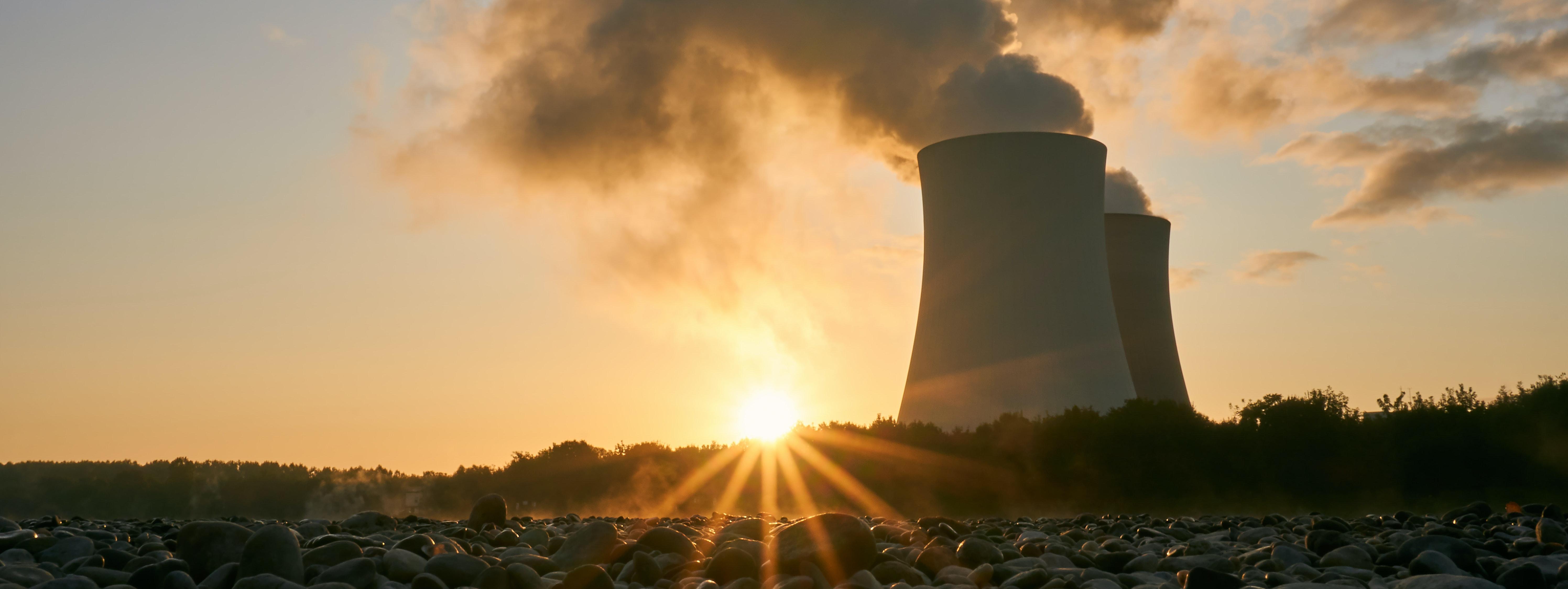Can Nuclear Energy Help Us Fight Climate Change?
The debate about nuclear energy has been raging for decades. Its advocates say it is a clean, efficient source of energy while its opposers say it is highly dangerous (think Chernobyl), expensive and not as clean as the other side might claim.

In nuclear reactors, power is produced through a process called nuclear fission. Here, uranium atoms are split which causes heat that turns water into steam. The steam turns turbines which, in turn, create electricity.
The first nuclear reactor was designed in the early 1950s in Idaho, USA. Shortly after, the US, UK, Russia, France and Germany were the pioneer countries who started to use the technology on a commercial scale and were later followed by another 20 countries as the industry reached its peak in the 1970s. After 1985 the popularity of nuclear energy took a nosedive as the price of oil started to decrease and, most importantly, as the world witnessed the disaster in Chernobyl, Ukraine in 1986. Chernobyl elicited political reactions as countries like Germany immediately announced a plan to phase out nuclear energy over the subsequent years. Italy shut down all of their nuclear operations just one year later, making it the first-ever ‘non-nuclear’ energy country. Despite this and other disasters, like Fukushima in Japan in 2011, over 400 nuclear reactors can still be found around the world and the industry is actually gaining some traction as the fossil fuel industry is dying and the climate crisis increases in urgency.
The Case for Nuclear
The two main arguments in favour of nuclear energy are that it has very low emissions and that it provides a constant supply of energy as opposed to solar and wind technology for example.
It is considered a low-carbon source of energy because nuclear energy generation does not emit greenhouse gases directly and that its lifecycle has a very low carbon footprint. In fact, it is generally agreed that its carbon footprint is as low as that of wind energy. Some studies have suggested that nuclear energy has prevented 60 billion tonnes of CO2 release since 1970 amounting to anywhere between 1.2 to 2.4 gigatonnes of CO2 every year. Of course, this is based on the assumption that oil or coal industries would otherwise take its place.
On the other hand, a lot of research has contradicted these claims and there are other, very serious, drawbacks to nuclear energy generation which must be taken into consideration.
Nuclear energy is expensive
It is not just coal and gas prices that are rising. Nuclear energy is extremely pricey and those costs are increasing year after year. All the while, the cost of solar and wind energy technology is dropping fast, is currently a third of the cost of nuclear, and takes significantly less time to build. Nuclear plants are very expensive to build and they are very expensive to run. What’s more, their complexity means that any technical problems that the plants encounter can end up causing very long shutdowns.
Research claiming that nuclear could have a role to play alongside renewables in order to stop global warming at no more than 2°C (which most would argue is already too high) has estimated that an investment of $4 trillion would be required. As much as half of this spectacular amount would be needed for decommissioning old nuclear plants.
So nuclear does not make much sense financially. In fact, China and Russia are the only two countries in the world who are investing in new nuclear projects.
The “constant energy” debate is losing relevance
Its supporters will tell you that nuclear can provide you with clean energy when the sun doesn’t shine and the wind doesn’t blow. While this may have been true in the past, nowadays nuclear energy’s inflexibility is actually working against it.
It is true that solar and wind’s intermittency problem has not been solved completely yet but numerous solutions are being implemented or are in the pipeline such as; new, cheaper and more efficient energy storage solutions, more flexible power grids, reusing turbines from decommissioned fossil fuel industries, interconnectors between countries on a large scale and various other engineering tricks.
And if we’re talking about efficiency it might be worth noting that, as the effects of climate change increase, nuclear plants are running into all kinds of difficulties. It turns out that nuclear plants do not deal well with extreme heatwaves. In July 2019, 6 nuclear plants across Europe had to severely reduce their output or suspend their operations altogether since increasing temperatures negatively impact the equipment and heat up the water inside the plant which is used for cooling. The water’s cooling effects are vital for the plant’s safety and for the storage of the waste fuel created. According to the current trends, 26% of nuclear plants around the world will run into difficulties because of temperature increases by 2040. That percentage shoots up to 73% by 2060! Water for cooling will also be harder to come by as the number of droughts increase.
It is not as low-carbon as you may think
Some research has contradicted the argument that nuclear energy is as low-carbon as wind energy. Some studies have actually found that nuclear can be up to 4 times more carbon-intensive once you take the mining and processing of uranium, the decommissioning of old power plants, the processing of nuclear fuel and the issue of waste storage into account. What’s more, nuclear is the most water-intensive of all energy producers. It requires an average of anywhere from 1,101 to 44,350 gallons of water per megawatt it produces. When the water is discharged from the plant this has also been found to have negative effects on marine life and coastal environments.
Nuclear energy is unsafe
The issue of safety is one of the biggest counter-arguments of nuclear energy. When accidents occur in nuclear reactors, the consequences could be catastrophic. There have been a few accidents over the past decades but the most notable are Chernobyl and Fukushima. Together, these were responsible for 450,000 evacuations and cost anywhere between 320 to 460 billion euros. The death tolls of these disasters are difficult to discern and are the topic of much debate with the numbers ranging from tens to hundreds of thousands of people due to the long term consequences of radiation exposure.
Accidents can happen for various reasons including human error and explosions but also because of earthquakes, unexpected floods, and fires which will all increase in occurrence due to the climate crisis. A major disaster in any of the 450 plants across the world could expose dozens of millions of people to radioactive contamination.
Radioactive Waste
The process of generating nuclear energy produces waste of varying levels of radioactivity, the most problematic being High-Level Radioactive waste (HLW). The biggest cause for concern is that, as of yet, there are no long-term solutions of how to handle this waste. Around 12,000 tonnes of HLW is being produced every year meaning that there is currently 250,000 tonnes of highly radioactive material that needs urgent and permanent handling. The radioactivity from this waste can remain high for up to 1 million years!
Any reprocessing or disposal of such waste so far have all been temporary. The most popular solution at the moment is to bury the waste in specially designed reservoirs hundreds of metres below the ground. These containers are very expensive to build, have limited space, and do not provide 100% guarantee of protection against leakage. What’s more, not a single reservoir has been built which can be used as a permanent solution yet. Other plans for waste disposal put forward include dumping it at sea or blasting it into space. In essence, the most “serious” considerations for the management of highly radioactive, nuclear waste are; bury it, drown it or send it to space.
A lot of research and development is going into the nuclear industry and some of which is quite promising. That being said, while nuclear energy does have enticing factors, the downsides of the industry include trillions of euros worth of expenses, a decreasing lack of efficiency in a changing world, a number of “hidden” environmental costs, the risks of global catastrophe and unmanageable, highly radioactive waste. At the same time, the solar and wind industries are becoming more economically, sustainably, and technologically viable. It is hard to see why we would even consider nuclear energy as we move towards a better, more environmentally and socially just future.
The Author: JD Farrugia
-
Корисни линкови
26-01-2021 -
Справување со климатските промени и загадувањето на воздухот во градот Скопје
29-04-2018 -
Финансирање во климата
28-01-2022 -
Микронаративи
08-06-2022
{{"article.lastestPosts"|translate}}
-
Нови финансирања за унапредување на природата и биолошката разновидност на Зелената агенда за Западен Балкан
11-03-2025 -
Започна проектот за развој на 1-от и 2-от двогодишен извештај за транспарентност и 5-от национален извештај за климатски промени на С.Македонија
04-03-2025 -
Земјоделски форум за климатски промени: Се изнаоѓаат решенија за поголема климатска отпроност на заемјоделието
02-12-2024 -
Заврши COP29, центарален фокус на финасирањето за климата
02-12-2024




 Мод за знаковен јазик
Мод за знаковен јазик Говорен асистент
Говорен асистент Означи линкови
Означи линкови

 Зголеми маус
Зголеми маус